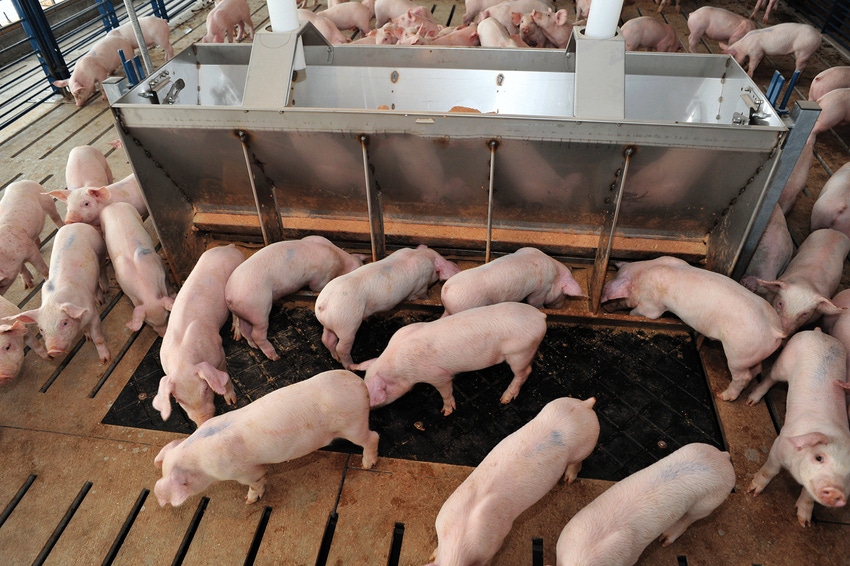Evaluation of soybean expellers fed to growing pigs
Is there a difference in nutritional value between conventional SBE and Photoseed SBE when fed to growing pigs?
March 23, 2023

New varieties of soybeans have been developed to increase production yields and nutritional values. However, improving yields often results in sacrificing the nutritional quality of the soybeans or vice versa. Photoseed soybeans was developed as a new soybean variety to improve both aspects. This technology consists of genetically modifying the plant to increase carbon capture; carbon is then stored as oil bodies in green tissue. The continuous carbon fixing cycles enhance photosynthesis and may also promote higher nitrogen fixation by rhizobia, which results in increasing protein content in the seeds. In addition, the production increases concentration of oil in Photoseed up to 18% and protein production may be increased by 3% per acre.
To our knowledge, there is no information on the nutritional value of the soybean expellers produced from the new soybean variety. Therefore, three experiments were conducted to test the hypothesis that the standardized ileal digestibility of AA, concentration of metabolizable energy, and the standardized total tract digestibility of P are not different between conventional SBE and Photoseed SBE when fed to growing pigs.
Experiment 1: SID of AA
In Exp. 1, nine barrows (30.0 ± 1.5 kg) with a T-cannula at the distal ileum were allotted to a triplicated 3 × 3 Latin Square design with three diets and three periods in each square. An N-free diet and two diets containing conventional or Photoseed SBE were used (Table 1).
Pigs were housed individually in fully slatted pens and ileal digesta were collected on day 6 and 7 of each period. Ileal digesta samples were lyophilized, ground and analyzed for AA, and the SID of AA was calculated. Results from Exp. 1 indicated that the SID of Lys was not different between the 2 SBE sources, but the SID of other indispensable AA were greater or tended to be greater in conventional SBE compared with Photoseed SBE (Table 2). It is possible that the greater concentration of trypsin inhibitors that were observed in the Photoseed SBE resulted in the reduced SID of AA. However, the concentration of standardized ileal digestible AA, which was calculated by multiplying the analyzed AA in each source of SBE by digestibility values, were not different between the two sources with the exception that Photoseed SBE had greater concentration of digestible Arg, Lys, Met and Trp compared with conventional SBE.
Experiment 2: Concentration of ME
In Exp. 2, 30 pigs (18.3 ± 1.3 kg) were randomly allotted to three diets containing corn, corn and conventional SBE, or corn and Photoseed SBE as energy sources. Pigs were housed in metabolism crates and feces and urine were separately collected for 4 d after 5 d of adaptation. Feces and urine were analyzed for gross energy and concentrations of digestible energy and ME were calculated in each diet. Results from Exp. 2 indicated that concentrations of DE and ME were not different between the two sources of SBE if expressed on an as-is basis (Table 3). On a DM basis, concentration of DE in Photoseed SBE tended to be greater than in conventional SBE, but ME was not different between the two sources of SBE.
Experiment 3: STTD of P
In Exp. 3, 48 barrows (12.0 ± 1.6 kg) were allotted to six diets containing two sources of SBE (i.e., conventional vs. Photoseed) and three levels of microbial phytase (i.e., 0, 500 or 1,000 units/kg). Pigs were housed in metabolism crates and feces were collected quantitatively for 4 d after 5 d of adaptation. Fecal samples were dried and analyzed for P and the STTD of P was calculated. Results from Exp. 3 indicated that there was no interaction between SBE source and increasing phytase in the diets fed to pigs (Table 4). Increasing phytase in the diets linearly increased the STTD of P in both sources. The STTD of P in Photoseed SBE tended to be greater compared with conventional SBE, which was mostly a results of the increase in the STTD of P in the Photoseed SBE diet containing phytase at 500 unit/kg.
In summary, Photoseed SBE contained more nutrients and less fiber compared with conventional SBE. The concentrations (g/kg) of standardized ileal digestible AA were not different between the two sources for most AA but concentrations of Arg, Lys, Met and Trp, were greater in the Photoseed SBE compared with the control SBE. The Photoseed SBE also tended to contain more ME and to have greater STTD of P than conventional SBE. It is concluded that if Photoseed SBE is included in diets for pigs instead of conventional SBE, the nutritional value of the diet will not be compromised and may be slightly increased.
You May Also Like



